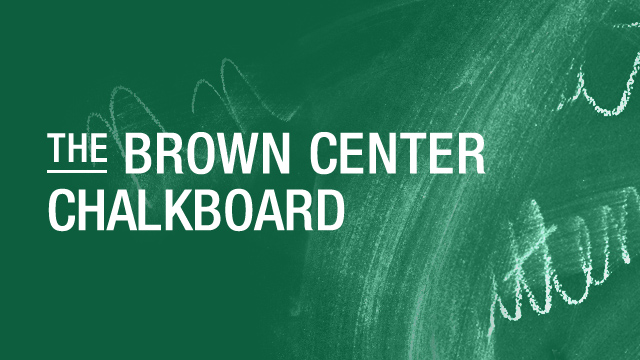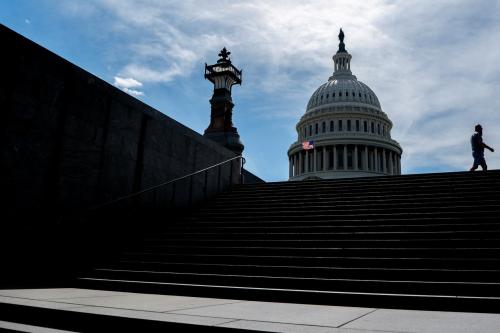After some eleventh-hour twists and turns, Congress ultimately included a tax-credit scholarship program in the One Big Beautiful Bill Act (OBBBA). I outlined my concerns about earlier drafts of the bill (then called ECCA)—again and again and again—on this blog. In short, Congress sought to impose a 50-state, voucher-like program with hardly any quality control mechanisms or protections against discrimination and waste.
The scholarship program, as passed, is terribly flawed, which I’ll get to in a minute. It’s also not fully settled, since it awaits a rulemaking process within the U.S. Department of the Treasury that should provide more details about how it will work.
Still, those late twists and turns brought us to a pretty interesting place. State leaders will need to decide whether to opt into a program that could become a major source of federal education funding. Red-state Republicans are sure to opt in. Blue-state Democrats have a decision to make. The question is whether they can mold this program into something that aligns with their states’ priorities. And it seems possible. There’s a way to squint at this law, flawed as it is, and see how this could become a boon for educational choice in red states and educational enrichment in blue states.
What is this thing?
Let’s start with a brief overview of what this law says and how it changed in that eleventh hour. If you’re interested in more details, I’d encourage going straight to the legislative text (Sec. 70411), which itself is quite brief.
Here’s how this program works. An individual can donate money to a scholarship-granting organization (SGO), which then gives “scholarships” to families to pay for eligible educational expenses. Individuals can donate up to $1,700 (in cash) to SGOs, and they receive a 1:1, nonrefundable tax credit for doing so. In other words, if you give $1,700 to a qualifying SGO, you’ll owe $1,700 less to the IRS at tax time. SGOs can keep up to 10% of that money for themselves. They send the rest to families to cover the types of K-12 expenses allowed with Coverdell ESAs. That includes private school tuition. It also includes expenses like tutoring and technology costs for students enrolled in private or public schools.
State leaders can decide whether to participate in the program. They can also set rules for the SGOs within their borders. For example, a state could prohibit SGOs from discriminating based on sexual orientation or religion, and it could require SGOs to provide certain performance-related information (e.g., test scores for scholarship recipients).
It’s worth highlighting a couple of the (many) major changes from the bill’s earlier drafts.
First, and most importantly, states have control. They can decide whether—and, in a sense, under what terms—to opt in. Past versions of the bill required all states to participate, and some drafts explicitly prohibited them from regulating SGOs and/or private schools.
Second, for this program to be well funded, many people will need to make relatively small donations. Earlier versions would have created a tax shelter that enabled a few wealthy “donors” to fund the program while making money for themselves (by donating stock and avoiding capital gains taxes). That’s not an option here.
So, the late revisions addressed a couple of issues. Other issues remain, but there’s reason for state leaders to consider how they could make this work for their states.
What happens from here?
We can game this out a bit, even without knowing exactly what will happen in the rulemaking process.
In red states, GOP leaders will use this to supplement their state-level voucher, ESA, and tax-credit scholarship programs. Raising money will be harder than advocates expected, since they can’t rely on a few donors to bankroll the program (via the tax shelter). Still, there’s a natural group of front-line recruiters: private school leaders. These leaders can explain to parents how donating to an allied SGO could bring resources to their school at little to no cost to the family.
In blue states, there are three basic possibilities:
First, there’s the “never, ever, ever” approach. That is, Democrats could just refuse to participate in a program built by private school choice advocates to advance private school choice—even if that means declining federal funding. The more this program ultimately looks like a voucher program, the more likely this approach becomes. Politically, that could happen if the program is branded as the federal voucher program. Substantively, it could happen if the Treasury Department’s rules prevent states from determining what types of SGOs are eligible for funding.
Second, there’s the “suck it up” approach of opting into a school choice program (with strings attached). Some analysts, including Mike Petrilli, believe the GOP has put Democrats in a bind like the one that Democrats put the GOP in with Medicaid expansion. That is, either opt into this program or explain to your residents why they can’t get resources available to other states. Even in this scenario, blue-state leaders would try to set some limits, like preventing programs from turning students away based on their sexual orientation—and maybe restricting eligibility to low-income families. Fundamentally, though, this approach would entail Democrats opting into a private school program.
A subset of the Democratic Party might like this approach. Jorge Elorza, the CEO of Democrats for Education Reform, has implored Democrats to:
“Explore innovative funding models such as education savings accounts (ESAs), vouchers, and tax credit programs. Instead of rejecting them offhand, how do we shape these tools to align with Democratic values?”
The premise is that Democratic leaders need to align their positions with voters’ positions. Some polling—largely from advocacy groups—suggests that many Democrats (especially nonwhite Democrats) support school choice initiatives. (A counterpoint is that when private school choice initiatives hit the ballot, voters of all political stripes tend to oppose them.)
I have a hypothesis about public opinion on school choice. I suspect that many Democrats are drawn to positive arguments about how choice policies could create new educational opportunities. I doubt they’re drawn to negative arguments about how school choice could harm public schools and unions. Yet, today’s school choice movement seems increasingly hostile to public schools in both their rhetoric and policy design. Even among Democrats who want more choices, I don’t sense an appetite for driving a stake through the heart of public education. In other words, I think Elorza is right that many Democrats want more opportunities and aren’t satisfied with the status quo. I think he’s very wrong if he believes they’re looking for a diet version of the 2025 GOP school choice agenda.1
This brings us to the Democrats’ other potential approach.
Third, they could make this an educational enrichment program (in the broad sense), not an educational choice program (in the narrow sense). Recall, the final language of the OBBBA allows scholarship funds to cover a variety of expenses for private and public school students alike. For example, they could cover academic tutoring. They could cover computer technology, books and supplies, or AI-based educational software. They could cover special needs services. They could cover transportation or enrollment costs to attend specialized classes not available in a student’s own school. They could cover after-school programs. And that’s just a partial list.
These funds could be used for all kinds of educational enrichment. For Democrats drawn to the idea of enriching their children’s education, whether through school choice or supplemental resources, this could have appeal. It offers a type of “choice” that isn’t inherently threatening to public schools. Families can customize and enrich their kids’ education without undermining institutions that many Americans value.
Really, if advocacy groups like the American Federation for Children are sincere about helping families find the “best K-12 education for their children”—the positive case for school choice—they should embrace the idea that customization might look different in red states (choice) and blue states (enrichment). In fact, it could look different from one state to the next, with the program taking on as many forms as there are states.
If, instead, these groups are hellbent on making this a federal private school voucher program, they’ll lose Democrats’ interest—and create an easy target for the next time that Democrats control the budget reconciliation process.
Bad policy design, even if it’s a good policy to opt in
This might sound contradictory, but I don’t think it is. This tax-credit scholarship program is a terribly flawed vehicle for providing federal funds. It also might be a program that’s worth opting into for red and blue states alike.
A detailed discussion of the policy flaws will need to wait for another piece, but it’s worth mentioning a few. For one, we’re leaving (potentially) billions of dollars of tax revenue allocation to the whims and self-interests of donors, SGOs, and scholarship recipients. We have no idea to whom, or what, these funds will go, and there’s only so much that any local, state, or federal government can do to influence that. Further, this program has hardly any accountability, transparency, or quality control mechanisms. Maybe states will build them in; maybe they won’t. The potential for waste, fraud, and abuse remains vast. And if nothing else, we’re about to create a group of intermediary organizations—SGOs—that will siphon 10% of the funds from what could become one of our largest federal education programs.
Yet, whether this is good policy design isn’t the question before state leaders. They have to figure out whether to opt in. And that’s a plenty-complicated question of its own.
-
Footnotes
- Tangential support for this idea comes from a USC-UAS survey showing that the vast majority of Democrats would prefer that funds be provided to public education rather than to low-income families to pay for private school.
The Brookings Institution is committed to quality, independence, and impact.
We are supported by a diverse array of funders. In line with our values and policies, each Brookings publication represents the sole views of its author(s).







Commentary
The OBBBA’s tax-credit scholarship program is a mess that might be worth opting into anyway
August 5, 2025